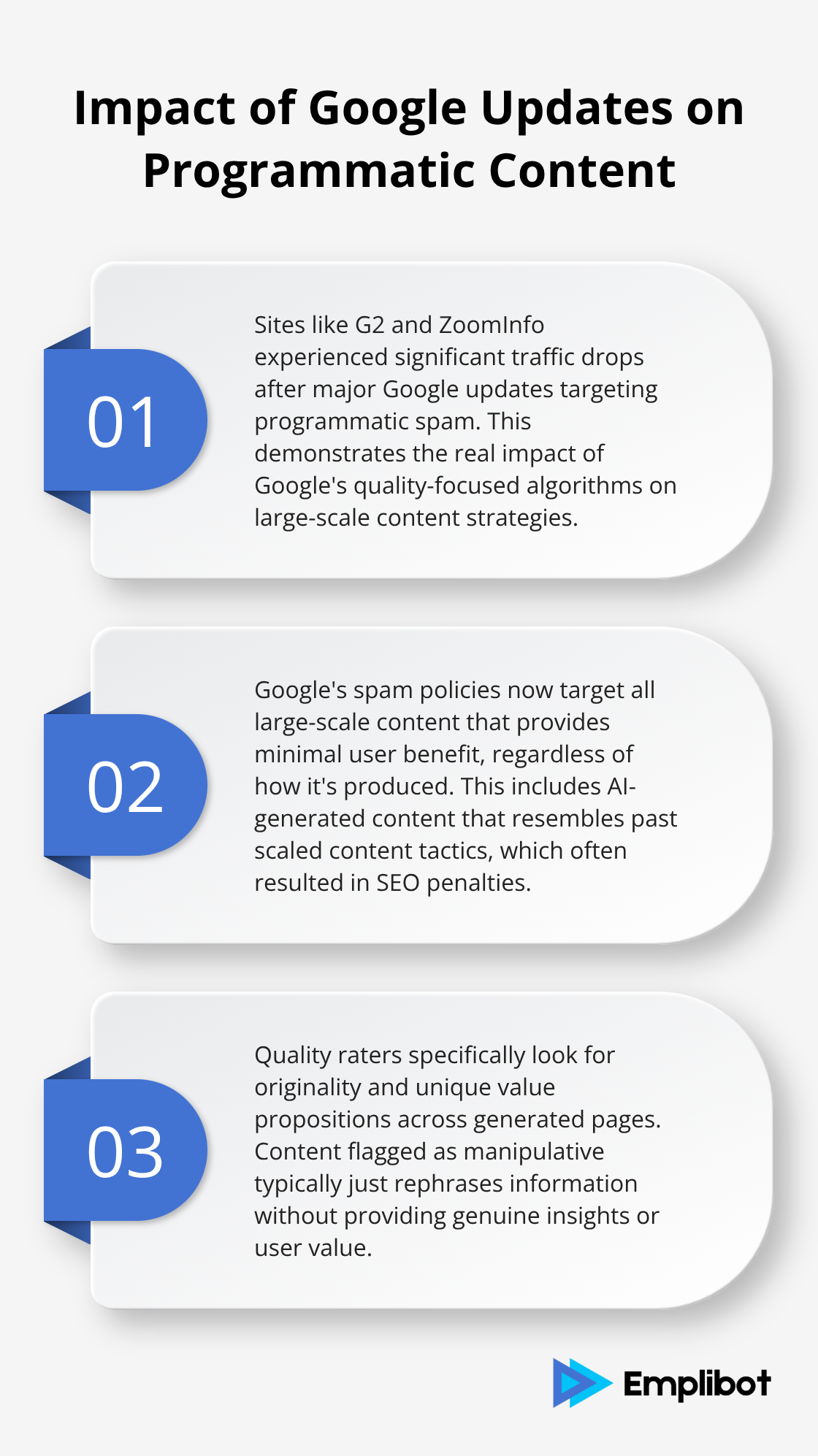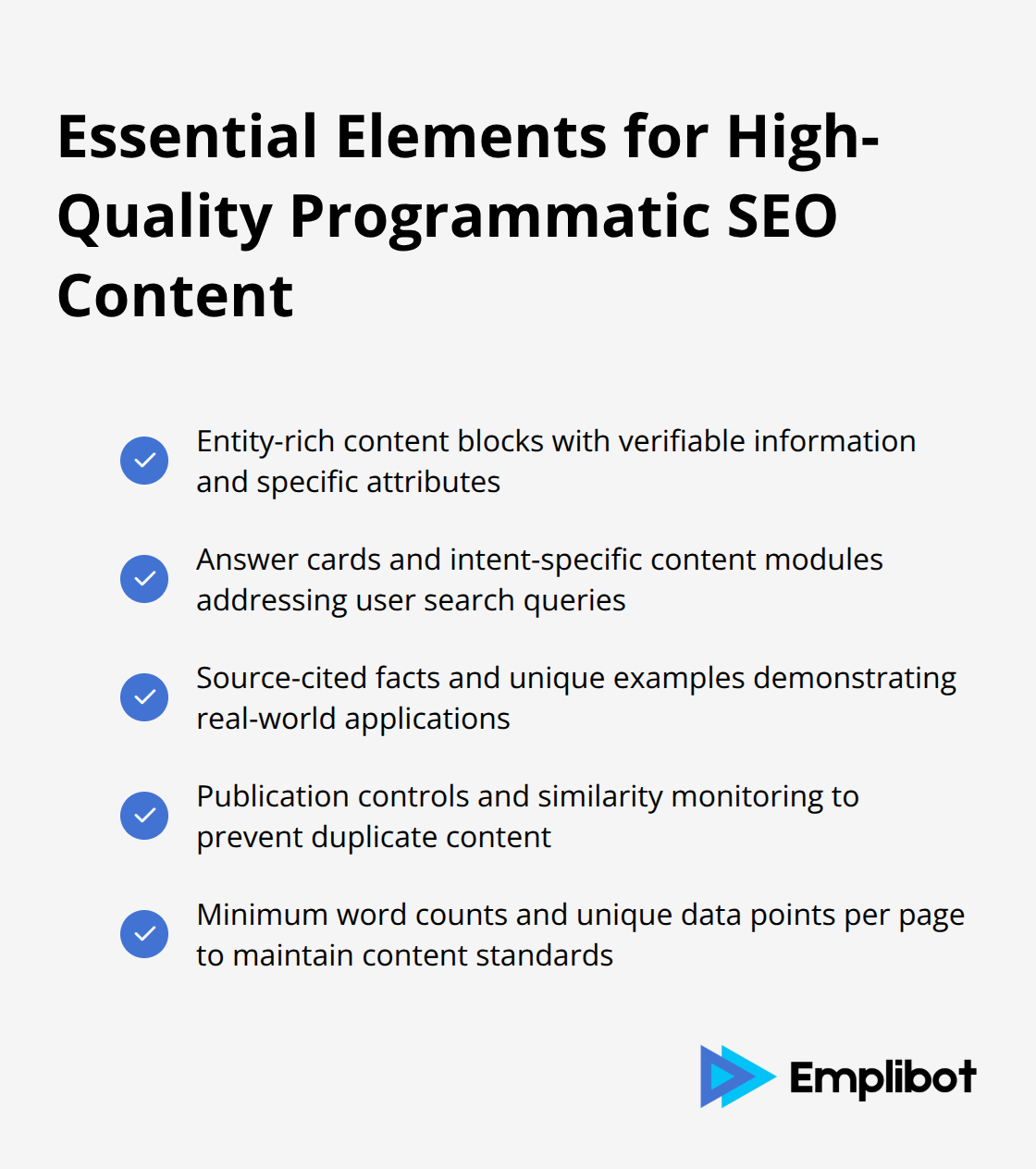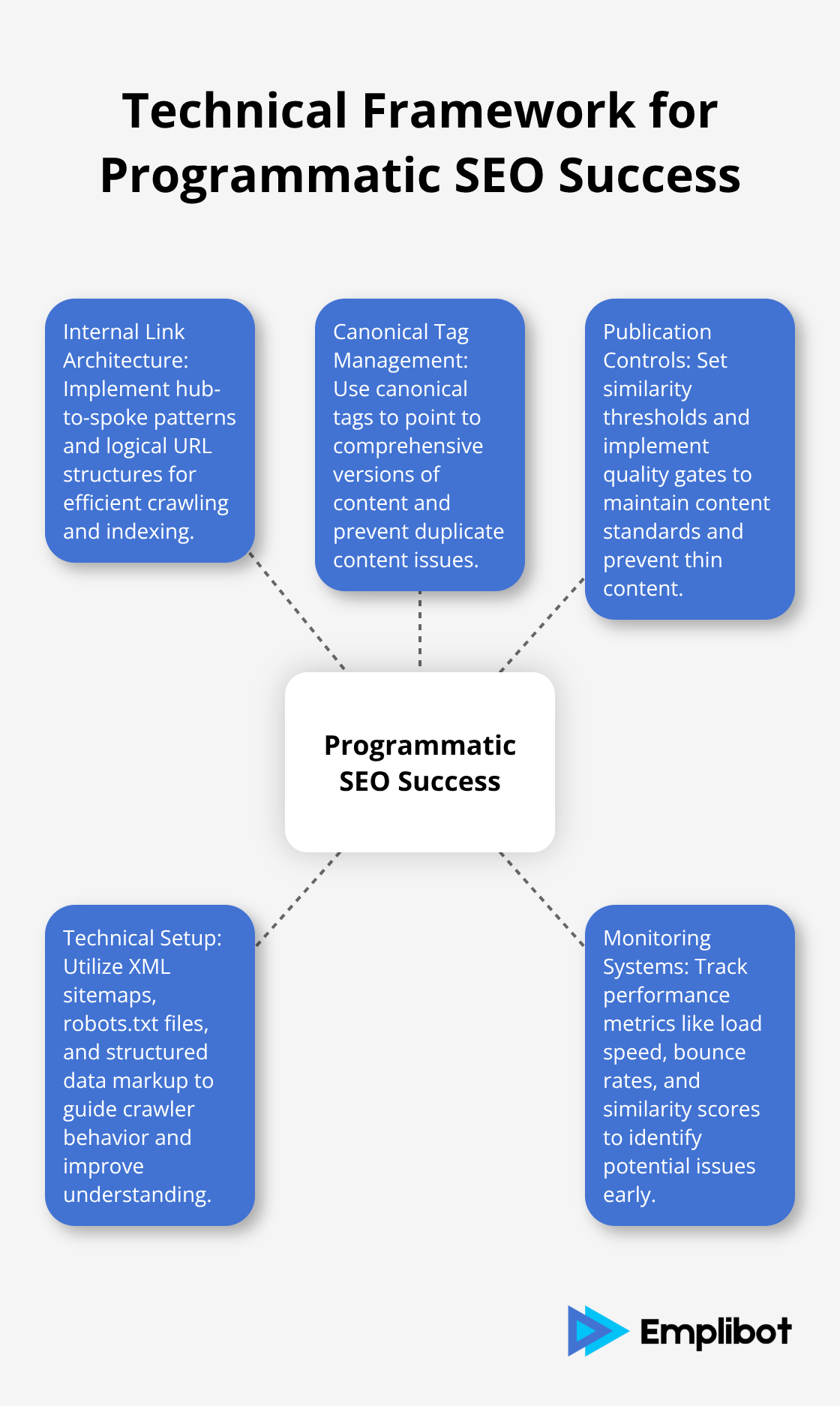Google’s latest guidelines make it clear that large-scale low-value pages violate their scaled content abuse policies, regardless of how they’re produced.
We at Emplibot understand that programmatic SEO without thin pages requires a fundamentally different approach than traditional mass content generation.
The key lies in building modular templates with entity-rich content blocks, source-cited facts, and genuine user value at every touchpoint.
What Separates Quality Programmatic SEO from Content Spam?
Programmatic SEO creates pages automatically through data templates and structured content, but Google’s quality rater guidelines now classify mass-produced content as the lowest quality when it lacks originality. Danny Sullivan from Google explicitly states that AI-generated content resembles past scaled content tactics that resulted in SEO penalties. The difference between legitimate programmatic SEO and scaled content abuse comes down to user value and content depth.
Google’s War on Low-Value Mass Content
Google’s spam policies target large-scale content that provides minimal user benefit, regardless of production method. Sites like G2 and ZoomInfo experienced significant traffic drops after major Google updates that specifically targeted programmatic spam. The search engine now flags content as manipulative when it simply rephrases information without genuine insights. Quality raters specifically look for originality and unique value propositions across generated pages.

The 2025 Content Quality Benchmark
High-quality programmatic content must include proprietary data, user-generated elements, or structured information that competitors cannot easily replicate. Successful examples like Wise’s 8.5 million currency converter pages generate over 100 million monthly visits because each page provides unique conversion data and contextual financial information. Tripadvisor leverages authentic user reviews and location-specific data to create differentiated travel pages.
Template Quality vs Template Quantity
The most successful programmatic strategies focus on template sophistication rather than volume output. Each template must solve specific user problems with data-rich content blocks that competitors cannot duplicate. Sites that prioritize quantity over quality face algorithm penalties (particularly after Google’s helpful content updates). Smart programmatic SEO requires templates that adapt content based on entity relationships and user search intent patterns.
This foundation sets the stage for the technical framework that transforms basic templates into user-focused content machines.
How Do You Build Templates That Pass Google’s Quality Tests?
Entity-Rich Content Blocks That Scale
Modern programmatic templates need structured content blocks that contain specific entity data rather than generic placeholder text. Each content block must include verifiable information about locations, products, or services with concrete attributes like pricing data, availability schedules, or technical specifications. Zillow’s real estate pages demonstrate this approach by incorporating property details, neighborhood statistics, and market trends into each template section.
The template architecture should map database fields to content elements where each field contains factual data that changes meaningfully across pages. Content blocks work best when they combine multiple data sources to create comprehensive information sections that competitors cannot easily replicate through simple database queries.
Answer Cards and Intent-Specific Content Modules
Template design must include answer card modules that directly address user search queries with specific solutions rather than general information. Each template needs distinct content modules for different user intents such as comparison cards for product research, calculation tools for financial queries, or location-specific data for local searches.
Zapier’s integration pages succeed because they provide specific connection instructions and use case examples for each software combination rather than generic integration descriptions. Template fields should connect to user intent patterns where informational queries receive detailed explanations, transactional queries get pricing and availability data, and navigational queries provide direct access paths.
Source Citation and Unique Example Requirements
Source-cited facts must appear in every content module with attribution to authoritative sources, while unique examples should demonstrate real-world applications specific to each page’s focus area. Each page requires at least one verifiable statistic or data point that supports the main content theme (whether from industry reports, government databases, or company research).
Unique examples work best when they reference specific companies, locations, or scenarios that relate directly to the page’s target keyword. This approach prevents the generic case studies that Google’s quality raters flag as low-value content.

Publication Controls and Similarity Monitoring
Similarity score monitoring becomes essential when templates generate multiple pages daily, requiring publication caps when content overlap exceeds predetermined thresholds to prevent duplicate content penalties. Smart publication systems should analyze content similarity before page creation and halt production when duplicate risk increases.
These template foundations create the technical framework that supports sophisticated internal link structures and canonical management systems. Remember that scaled content abuse occurs when many pages are generated primarily for manipulating search rankings rather than helping users.
What Technical Framework Prevents Programmatic SEO Penalties?
Internal Link Architecture and URL Structure
Strategic internal link architecture forms the backbone of successful programmatic SEO implementation. Hub-to-spoke patterns work best where category pages link to specific entity pages, while spoke-to-spoke connections create topical clusters that demonstrate content relationships. URL structure must follow predictable patterns with category hierarchies like /location/city-name/ or /product-type/specific-model/ that search engines can crawl efficiently.
Smart URL parameters follow consistent conventions with hyphens that separate words and logical category structures. These structures support both user navigation and search engine understanding while maintaining clean, readable paths.
Canonical Tag Management and Duplicate Prevention
Canonical tags should point to the most comprehensive version of similar content, which prevents duplicate content issues when multiple pages target related keywords. Smart canonical management involves master pages for high-volume keyword clusters while canonical tags consolidate ranking signals from similar variations.
Technical monitoring systems must track similarity scores across pages with publication controls that halt content creation when overlap exceeds 75% similarity. This approach prevents scaled content abuse violations where penalties range from ranking demotions to complete removal from search results.
Publication Controls and Quality Gates
Implementation requires similarity thresholds set at specific percentages rather than vague guidelines. Pages that share more than 70% content similarity trigger automatic review processes before publication (preventing thin content issues that harm rankings).
Publication controls work best when they include daily caps on new page creation and content freshness requirements that update existing pages before new ones appear. Quality gates require minimum word counts and unique data points per page to maintain content standards.
Technical Setup and Monitoring Systems
Technical setup includes XML sitemaps segmented by content type, robots.txt files that guide crawler behavior, and structured data markup that helps search engines understand page relationships. These elements work together to create a technical foundation that supports large-scale content without triggering spam filters.
Monitoring systems track page performance metrics including load speed, bounce rates, and similarity scores across the entire programmatic content library. This data helps identify potential issues before they impact search rankings or user experience.

Final Thoughts
Programmatic SEO without thin pages demands a strategic shift from mass content creation to value-focused automation. The difference between successful programmatic strategies and scaled content abuse lies in template sophistication, entity-rich data integration, and genuine user problem-solving capabilities. Sites that implement modular templates with source-cited facts and unique examples per page create sustainable competitive advantages while avoiding Google’s quality penalties.
The long-term benefits extend beyond traffic generation to include improved user engagement, higher conversion rates, and algorithm resilience. Quality programmatic content builds domain authority through comprehensive coverage of user intent patterns rather than keyword stuffing tactics that trigger spam filters. Future-proofing requires continuous monitoring of similarity scores, publication controls, and content freshness standards that adapt to evolving search algorithms.
While programmatic SEO focuses on automated scale, Emplibot takes a different approach by producing high-quality, engaging content tailored to your business through comprehensive keyword research and SEO optimization. This distinction matters as search engines increasingly reward authentic value over automated volume (particularly after Google’s helpful content updates). The choice between programmatic automation and quality-focused content creation shapes your site’s long-term search performance and user satisfaction.

